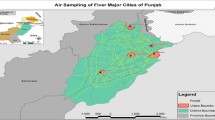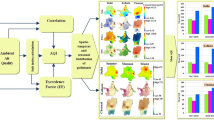Abstract
During 2003–2004, SUPARCO, the Pakistan Space and Upper Atmosphere Research Commission has conducted a year long baseline air quality study in country’s major urban areas (Karachi, Lahore, Quetta, Rawalpindi, Islamabad and Peshawar). The objective of this study was to establish baseline levels and behavior of airborne pollutants in urban centers with temporal and spatial parameters. This study reveals that the highest concentrations of CO were observed at Quetta (14 ppm) while other pollutants like SO2 (52.5 ppb), NO x (60.75 ppb) and O3 (50 ppb) were higher at Lahore compared to other urban centers like Karachi, Peshawar etc. The maximum particulate (TSP) and PM10 levels were observed at Lahore (996 ug/m3 and 368 ug/m3 respectively), Quetta (778 ug/m3, 298 ug/m3) and in Karachi (410 ug/m3, 302 ug/m3). In all major cities the highest levels were recorded at major intersections and variations were directly correlated with traffic density. These pollutants showed highest levels in summer and spring while lowest were observed in winter and monsoon. A data bank has been generated for future planning and air pollution impact studies.
Similar content being viewed by others
References
Dockery, D.W., & Pope III, C.A. (1994). Acute respiratory effects of particulate air pollution. Annual Reviews on Public Health, 5, 107–132.
Ghauri, B., Manzar, S., & Mirza, M.I. (1994). An ssessment of air quality in Karachi, Pakistan. Environmental Monitoring Assessment, 32, 37–5.
Hameed, S., Mirza, M.I., Ghauri, B.M., Siddiqui, Z.R., Javed, R., Khan, A.R., Rattigan, O.V., Sumizah, Q., & Husain, L. (2000). On the sources of widespread winter fog in northern Pakistan and India. Geophysical Research Letters, 27, 16 No.13, pp 1891–1894, July 01, USA.
IRIN News, http://www.irinnews.org/report.asp Report D-43590& Select Region Central_Asia & SelectCountry Pakistan.
Koenig, J.O. (2000). Health effects of ambient air pollution. Kluwer Academic Publishers, Boston/Dordrecht/London.
National Transport Research Cell, NTRC: http://www.moc.gov.pk/ntrc & http://www.ntrc.com.pk.
Oikawa, K. (1977). Trace analysis of atmospheric samples. Jhon Wiley Sons N.Y. 29.
Parekh, P.P., Ghauri, B., Siddiqui, Z.R., & Husain, L. (1988). The use of statistical methods to identify sources of selected elements in ambient air aerosols in Karachi, Pakistan. Atmospheric Environment, 21, 1267–1274.
Pope III, C.A., Burnett, R.T., Thun, M.J., Calle, E.E., Krewski, D., Ito, K., & Thurston, G.D. (2002). Lung cancer, cardiopulmonary mortality, and long-term exposure to fine particulate air pollution. Journal of American Medical Association, 287, 1132–1141.
World Bank document on Pakistan Strategic Country Environmental Assessment, Final Report, June 30 (2005).
Author information
Authors and Affiliations
Corresponding author
Rights and permissions
About this article
Cite this article
Ghauri, B., Lodhi, A. & Mansha, M. Development of baseline (air quality) data in Pakistan. Environ Monit Assess 127, 237–252 (2007). https://doi.org/10.1007/s10661-006-9276-8
Received:
Accepted:
Published:
Issue Date:
DOI: https://doi.org/10.1007/s10661-006-9276-8




